Sick or Evil or Both: “My Friend Dahmer” and the Coverage of White Killers
This HBO mini-series asks why a young white man turned to violence and finds no easy answers. But why do we only ask questions about certain kinds of killers?
For many people, Disney+’s debut show, The Mandalorian, was a breath of fresh air for the Star Wars universe. It featured a look at brand new characters in a brand new part of the universe. I enjoyed the season, though I felt it had its weak points. While we wait for season two, which is scheduled to drop on the service later this year, Disney+ is releasing an eight part behind-the-scenes look at the making of The Mandalorian. The first episode dropped on May the 4th, and the series concluded on June 20th.
I love watching behind-the-scenes featurettes for movies and shows. As an aspiring filmmaker myself, there is something utterly captivating about watching creators create. I love seeing the whole process of creating a piece of content, from pre-production to production to post-production. It shows you just how much teamwork and effort goes into making something, and it imbues me with an immense amount of appreciation for the filmmaking process.
Disney Gallery: The Mandalorian is eight half-hour episodes taking a look at the making of The Mandalorian.
Episode I: Directing
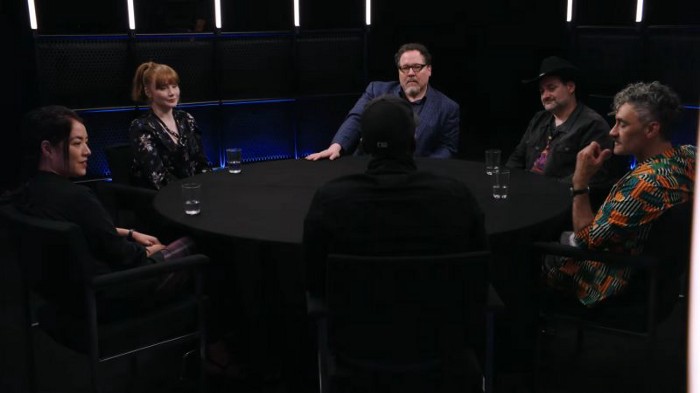
While this debut episode has a few dry parts, I found it to be largely interesting. The Mandalorian assembled an eclectic group of directors for the season, and it was with this round table discussion that I really processed how diverse their team is. It is mostly comprised of women and people of color. No woman or person of color has directed a Star Wars movie before, which is something that will hopefully be corrected soon. With this series, however, they brought together as diverse and talented of a team as they possibly could.
Going into the perspectives of these different directors, and their individual approaches to their episodes, is really interesting. It’s great to hear from Bryce Dallas Howard how she chose to tackle her episode, which became one of the most challenging ones to film. It also ended up being one of my favorite episodes of the season, just behind Taika Waititi’s season finale. This episode presents an interesting contrast between directing approaches, as you see the hyper-prepared and focused Deborah Chow compared to the more relaxed Rick Famuyiwa.
One thing I really took away from this episode is the leadership qualities of Jon Favreau. As the showrunner, he really knew what qualities he was looking for in the directors he brought on board, and how he wanted this to be a creatively collaborative process. In addition to being a great director, Favreau is great at working with directors and bringing the best out of them. He also knows when to take a step back and let the directors take the reins in order to tell the story the best way possible.
Episode II: Legacy
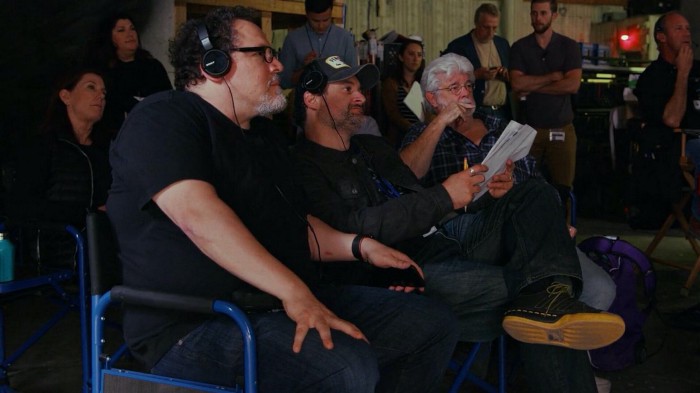
While I really liked the first episode, the second episode of Disney Gallery is rather disappointing. This episode focuses on the legacy of Star Wars and how much the people working on this show were influenced by George Lucas’ creation. In theory, this is an interesting aspect to explore, but not for an entire episode of a limited eight-part series. It doesn’t really tell us anything new, as any fan of Star Wars knows why they like Star Wars and why other people like it too. It certainly doesn’t tell us anything about The Mandalorian, as this episode has virtually nothing to do with the series.
There are some interesting tidbits in the episode, such as Dave Filoni’s story about “Duel of the Fates” and his analysis of the storyline tying Episode I to Episode VI. While interesting, it doesn’t really contribute anything to what this series is supposed to be about: the making of The Mandalorian. Upon watching it, this second episode feels like filler and ultimately a waste of time. There are so many different aspects of the making of this series that could be explored, and to spend so much time on something so redundant simply feels like a missed opportunity.
Episode III: Cast
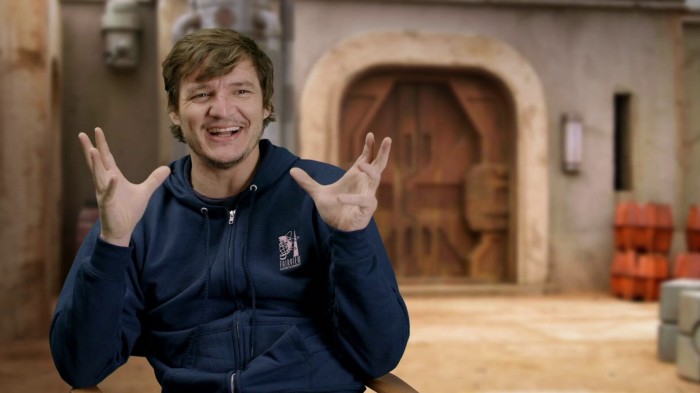
This episode goes into the series’ cast, focusing specifically on Pedro Pascal, Gina Carano, and Carl Weathers. While there are some really interesting topics that are covered, I don’t think they needed an entire episode devoted to the cast. I personally feel like it’s something that could have instead been touched upon in another episode.
That being said, there are some great stories told from the round table, specifically the stories of how Favreau and Filoni brought Carano and Weathers onto the project. Filoni, who comes from an animation background, tells a story about directing a screen test during pre-production, which was the first time he had ever directed live action. He talks about how difficult it was to get it right with the actors being in such heavy costumes that limited their mobility, ending with “All I could think about was how much quicker it would’ve been to draw this.”
Carl Weathers has a point he makes where he talks about how, when you’re acting, a lot of your performance comes from playing off of the other person. When the person you’re acting off of is completely covered by a helmet and you can’t see their face or eyes, a lot of effort goes into your own performance to try to read the moment and figure out the best way to react. I think this is a really great point that elevates all of the supporting cast that spend every episode acting off of an expressionless Mandalorian.
Episode IV: Technology
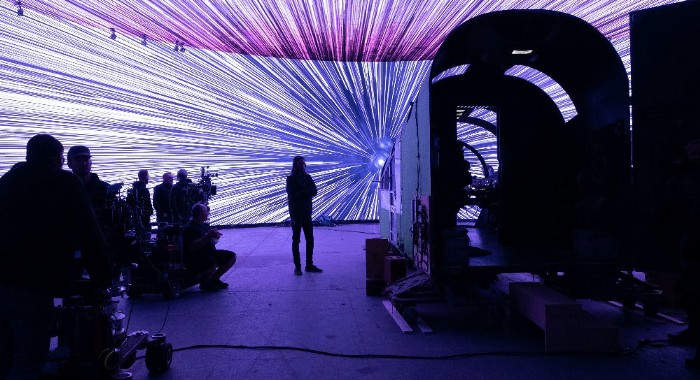
This episode delves into the revolutionary technology used to bring the world of The Mandalorian to life. This has been my favorite episode of the series so far. It takes you through their process of bringing all of these different aspects of preexisting technology together and using them in a way that had never previously been done. Using LED screens for the walls and ceilings, they were able to essentially shoot green screens in-camera, and have the full effects on-set for the actors to immerse themselves in.
Jon Favreau talks about how the work he did on The Jungle Book (2016) and The Lion King (2019) helped inform his approach to making The Mandalorian. I highly recommend watching the full behind-the-scenes featurette for the making of The Lion King on Disney+, as it is absolutely incredible what they did to make that film. Having seen that, it is very clear how the technology used on The Mandalorian is an extension of what was used for The Lion King.
This is technology that I think is very quickly going to become widespread in the industry, as it is a far better alternative to green screens. It looks more authentic, and it gives the actors something real to guide their reactions. It’s going to be incredible to see how this technology evolves and how it is implemented in other productions.
Episode V: Practical
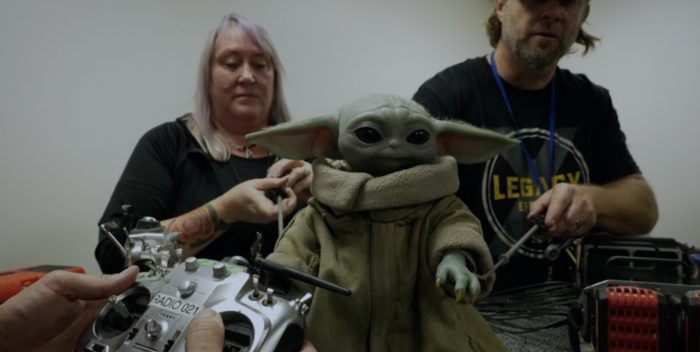
When The Mandalorian first debuted, what immediately took the world by storm was “Baby Yoda”. In this episode, all of the practical effects in the series — the prosthetics, the animatronics, the puppeteering, the miniatures, the props, and more — are explored in depth. A lot of time is spent on the process of bringing Baby Yoda to life, and the three people who work its controls.
One of the defining elements of Star Wars (1977) for me is the practical effects. When you first see all the different alien costumes in the Cantina, it cements what the feel and tone of this world. J.J. Abrams emulated this really well with Star Wars Episode VII: The Force Awakens (2015). A lot of the creatures and aliens in that film are elaborate practical costumes, and it makes the world feel so much richer. It is great to see that Jon Favreau brought that same mindset to The Mandalorian.
Favreau even goes so far as to use some stop motion animation for specific shots. Everything this episode touches upon is very much in line with the effects George Lucas used for the original trilogy. I appreciate Favreau’s approach so much because it would be rather painless for them to use CGI for every visual effect in the series. They very easily could have motion capture suits instead of practical costumes. They could use CGI to animate things instead of using miniatures or stop motion animation.
However, Favreau understands the mindset George had when he created the original films. He wants to be as true to the spirit of not just the movies themselves, but the process of how those movies were made. So he went out of his way in order to maintain that consistency. That to me is the sign of someone who is wholeheartedly invested in and commited to Star Wars.
Episode VI: Process
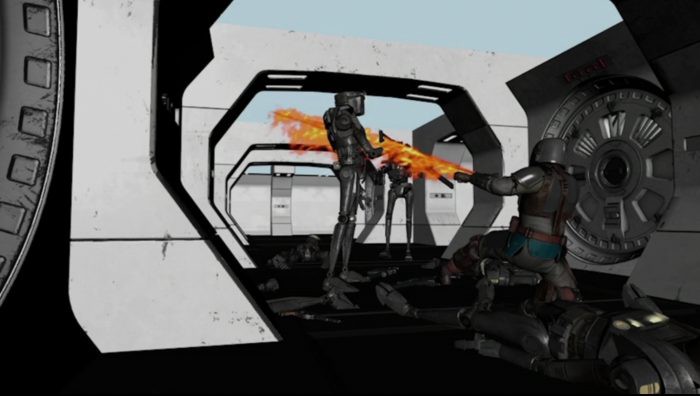
This episode delves into all the preparation that went into making each episode, specifically the extensive amount of pre-vis used to plot out every single shot. Pre-vis is a process where sequences — usually action scenes — are animated as a reference for the filmmakers so that they can plot out the scene and see how it flows prior to filming. It makes for an excellent blueprint for when they are on set shooting. For The Mandalorian, they used pre-vis to plan out the entirety of every single episode. Utilizing the technology pioneered by Favreau’s The Lion King, they were able to animate the entire season.
Deborah Chow talks about how this was a very different process from other television show episodes she’s directed. She says that usually she has about nine days to prepare for an episode before shooting; she was involved with The Mandalorian for two months before she stepped foot on set. For a show utilizing such groundbreaking technology and involving so many practical effects and extras, you need the “priceless preparation” time to make sure that when you get to set you know exactly what you’re doing.
Favreau equates filming this series to doing re-shoots for a comic book movie: you go in knowing exactly what you need, and you get it all done with no time to waste. While I wish this episode spent more time showing the writing and development process, I found everything it covered to be absolutely fascinating. It gives a great window into the process behind making such a big visual effects-centered show.
Episode VII: Score
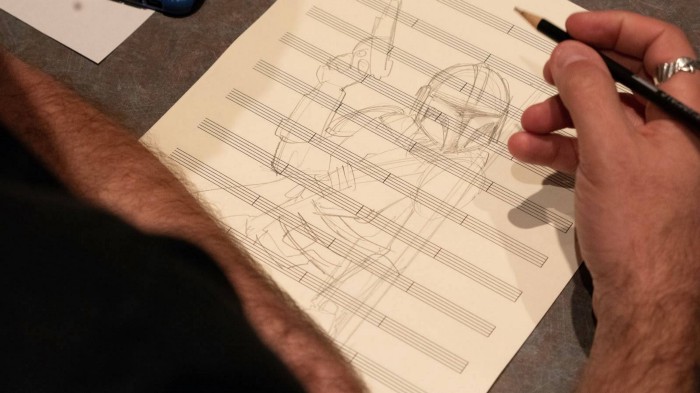
As Jon Favreau explains in this episode, one of the most important parts of Star Wars is the music. John Williams’ themes are some of the most iconic pieces of music ever created. Those are some pretty big shoes to fill when you’re joining a Star Wars project as the composer. This episode spends a lot of time with Ludwig Göransson, as he talks through his approach to crafting the score for The Mandalorian. As he points out early on, this isn’t just making the score for a movie; this is the equivalent to scoring three feature films.
Göransson — echoed by Favreau and Filoni — wanted to make something unique and different. He didn’t want to simply emulate Williams’ score. This is a brand new story, and a completely different offshoot of the Star Wars storyline. It needed to feel consistent with Star Wars while also having its own identity, and that is exactly what Göransson did. His experimentation with different recorders and other instruments he hadn’t used before are some of the most interesting parts of the episode.
While I am not a very musical person myself, I have always been fascinated by scores. They hold a unique ability to completely transform and elevate the tone of a movie or television show. Watching Göransson’s process in crafting the score, collaborating with Favreau and Filoni, and then recording it with a massive orchestra, is really fun to see.
Episode VIII: Connections
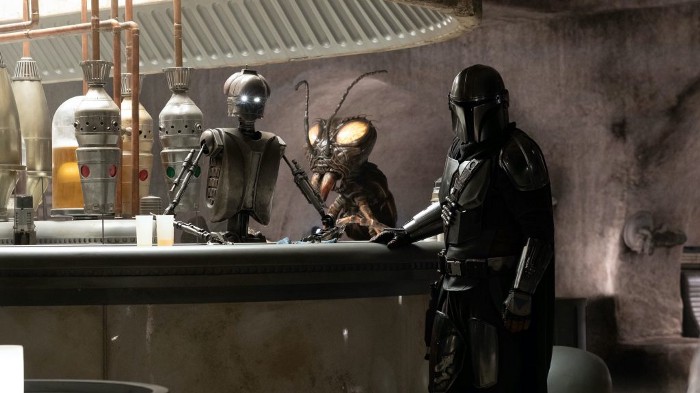
This is the final episode of Disney Gallery: The Mandalorian, and while it is certainly an interesting episode it doesn’t quite feel like a proper conclusion to this behind-the-scenes series. This episode delves into a lot of the easter eggs and deep cuts that are in The Mandalorian that tie into other parts of the larger Star Wars canon. There are so many tiny background details throughout the season that are revealed that show just how much love was put into making this show.
My biggest takeaway is just how big of a Star Wars nerd Jon Favreau is. Sprinkled throughout the series are some incredibly obscure references, ranging from random background characters in The Empire Strikes Back to weapons used in The Star Wars Holiday Special. It’s clear from the previous seven episodes that Favreau is a massive Star Wars fan, but this episode shows just how deep his knowledge actually goes. He is the perfect person to be showrunning something like The Mandalorian.
I enjoyed this episode a lot, but it didn’t feel like it was the final episode. I wish they had tied in some of the other elements that previous episodes touched upon in order to make it all feel a little more cohesive. A better conclusionary episode would have been talking about the fans’ reception to The Mandalorian, and what everyone thinks about the show as a final product. It just feels a bit anti-climatic. However, this is an incredibly informative episode that gives some great insight into the tiny details featured in The Mandalorian.
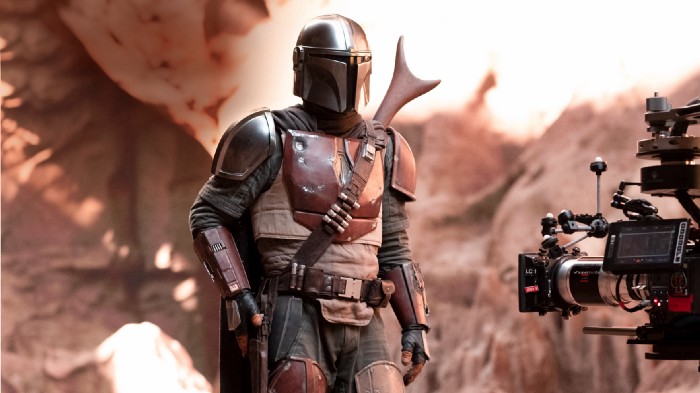
In the end, I feel similarly about Disney Gallery: The Mandalorian as I do The Mandalorian show itself: it has its ups and downs, but I ultimately enjoyed it. I am not a big fan of the second episode focusing on Star Wars’ legacy, as it feels like a filler episode that barely touches on The Mandalorian. Every other episode I really like, and some of them I think are fantastic. The technology and practical effects episodes are probably my two favorites.
I think one aspect of the show that was completely glossed over was the story development and screenwriting. While covering a lot of the pre-production, Disney Gallery never touches on how The Mandalorian came to be, who pitched what to whom, Favreau’s writing process, where the stories came from, and the rest of the story behind the project’s development. That to me feels like a major missed opportunity, and something that could have elevated Disney Gallery even more.
Having finished Disney Gallery, I have a bigger appreciation for The Mandalorian. One thing I respect even more about it now is the series’ diversity. Not only is there a great deal of diversity and inclusion on screen, but it is also incredibly prevalent behind the camera. I think that says a lot about Jon Favreau as a showrunner; as a White man, he used his position of power to bring on women and people of color to help tell the story, as well as making sure that the characters themselves are diverse. I think this ultimately epitomizes what a White man in Favreau’s position should be doing in order to give opportunities to people who don’t always have a shot at something as big and prestigious as Star Wars.
For anyone who has watched The Mandalorian on Disney+, I encourage you to also check out Disney Gallery: The Mandalorian.
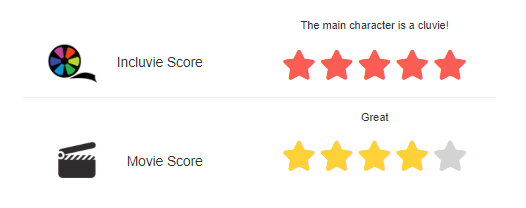
Author: Nathanael Molnár, originally published [6/22/2020]
Related lists created by the same author
This HBO mini-series asks why a young white man turned to violence and finds no easy answers. But why do we only ask questions about certain kinds of killers?
Related diversity category
A teen comedy that nobody wants to see.